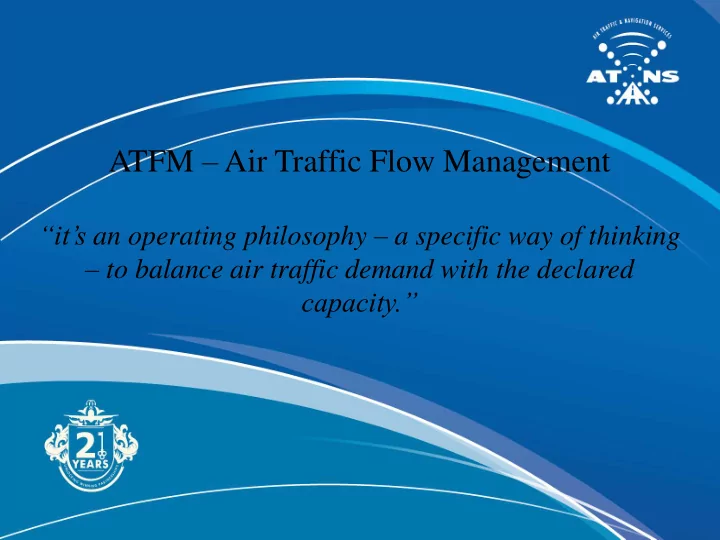

ATFM – Air Traffic Flow Management “it’s an operating philosophy – a specific way of thinking – to balance air traffic demand with the declared capacity.”
Scope The Concept of ATFM ATFM Objectives Demand & Capacity Balancing Capacity Constraint Triggers Advantages of Effective ATFM Conclusion
The Concept of ATFM Air Traffic Flow Management (ATFM) is a service established with the objective of contributing to a safe , orderly and expeditious flow of air traffic by ensuring that ATC capacity is utilised to the maximum extent possible, and that the traffic volume is compatible with the capacities declared by the appropriate ATS authority. Air traffic flow and capacity management has become a vital part of air traffic management in exploiting the full capacity of the air transport system without running the risk of infringing upon safety caused by overload situations.
The Concept of ATFM The concept of managing the flow of air traffic within the South African area of responsibility is not new. The Central Airspace Management Unit (CAMU), established at the O R Tambo ATC Centre officially opened in March 2001. The unit's responsibility includes, apart from managing the functions of the slot allocation program and flexible use of airspace (FUA) management, the management of air traffic flow and capacity management within South African sovereign and delegated airspace .
ATFM Objectives The objective of implementing an ATFM service is: To reduce ground and en-route delays; Maximise capacity and optimise the flow of air traffic; Provide an informed choice between departure delay, re-routing and/or flight level selection; Alleviate unplanned in-flight re-routing; and Assist ATS Units in planning for and managing future workload in the light of forecast increased traffic flows within South Africa; Assessing the impact of FUAs and TSAs on the air traffic control system;
ATFM Objectives Provide improved solutions around predicted severe weather; Balance the demand and capacity of ATC sectors; Determine the necessity for an airspace/ground delay program and other traffic management initiatives (TMls) and enact them;
Capacity & Demand Balancing In assessing capacity values, the following factors should be taken into account : the level and type of ATS provided; the structural complexity of the control area, the control sector or the aerodrome concerned; controller workload, including control and coordination tasks to be performed; the types of communications, navigation and surveillance systems in use, their degree of technical reliability and
Capacity & Demand Balancing availability as well as the availability of backup systems and/or procedures; availability of ATC systems providing controller support and alert functions; and any other factor or element deemed relevant to controller workload.
Capacity Constraints and Triggers Fleet Mix – the mix of aircraft influences many aspects of performance and capacity, including approach speeds, in-trail separation requirements, wake vortex separation, runway departure and arrival performance, avionic capability and others. Hourly Profile – the timing of scheduled arriving and departing flights throughout the day and even within each hour determines the volume of demand relative to available capacity, and as such, significantly influences the level of delay and congestion. User Mix – the type of airline, as it relates to commercial passenger operations, cargo operations, or general aviation activity, influences contact/remote stand assignments at the airport, which in turns influences runway assignment and performance.
Capacity Constraints and Triggers Origin/Destination Mix – the location of the origin for arrivals and the destination for departures influences the assignment by ATC of the terminal area arrival fix and the initial departure fix, which also influences runway assignment, particularly when ATC is applying a compass-mode runway assignment methodology. Typically triggers are quantitative measures of demand (e.g., annual, daily or peak hour movements or frequency of peak hours throughout a typical day), which will cause airports to deny operations (at times requested) or cause delays to reach a level that is unacceptable to aircraft operators and the travelling public. Triggers could also be defined based on routinely recorded delay metrics.
Advantages of Effective ATFM The centralized management and allocation of available capacity and the forward notice of abnormal capacity situations (e.g. extreme weather conditions). Tools to implement multiple delay programs that limit cost implications to airspace users due to abnormal capacity situations. Relieve air traffic controllers from a significant part of the work load and subsequently reduce stress levels during control operations. Provide to Aircraft Operators timely and accurate information on any event affecting the flow of air traffic and capacity of the airspace, and to propose effective solutions to minimize delays or to re-route traffic.
Advantages of Effective ATFM Improve capacity, sector productivity and support costs. Improve information distribution and co-ordination with the ATC system and other users, improving ‘system wide’ decision making. Expedite airport arrival, departure, taxiway and aircraft turnaround processes. Integrate all airspace users in ATM processes.
Conclusion ATFM is an enabler of air traffic management (ATM) efficiency and effectiveness. It contributes to the safety, efficiency, cost-effectiveness, and environmental sustainability of an ATM system. It is also a major enabler of global interoperability of the air transport industry. It is important to recognize that, over time, two threads of events are going to appear simultaneously: a) local ATFM implementations conducted worldwide are going to shape a global ATFM; and b) standardized ATFM processes will be implemented globally. ICAO Doc 9971, Part ii, Chapter 1
Thank You. Sandile Maphanga Manager: CAMU | Central Airspace Management Unit FAOR T: 011 928 6433 • F: 011 928 6420 • C: 082 085 3429 E: SandileM@atns.co.za • W: www.atns.co.za
Recommend
More recommend